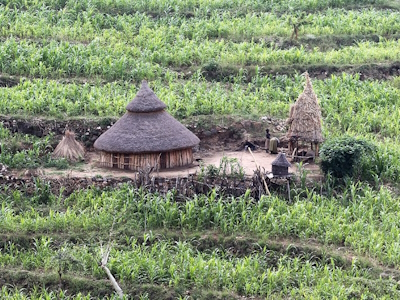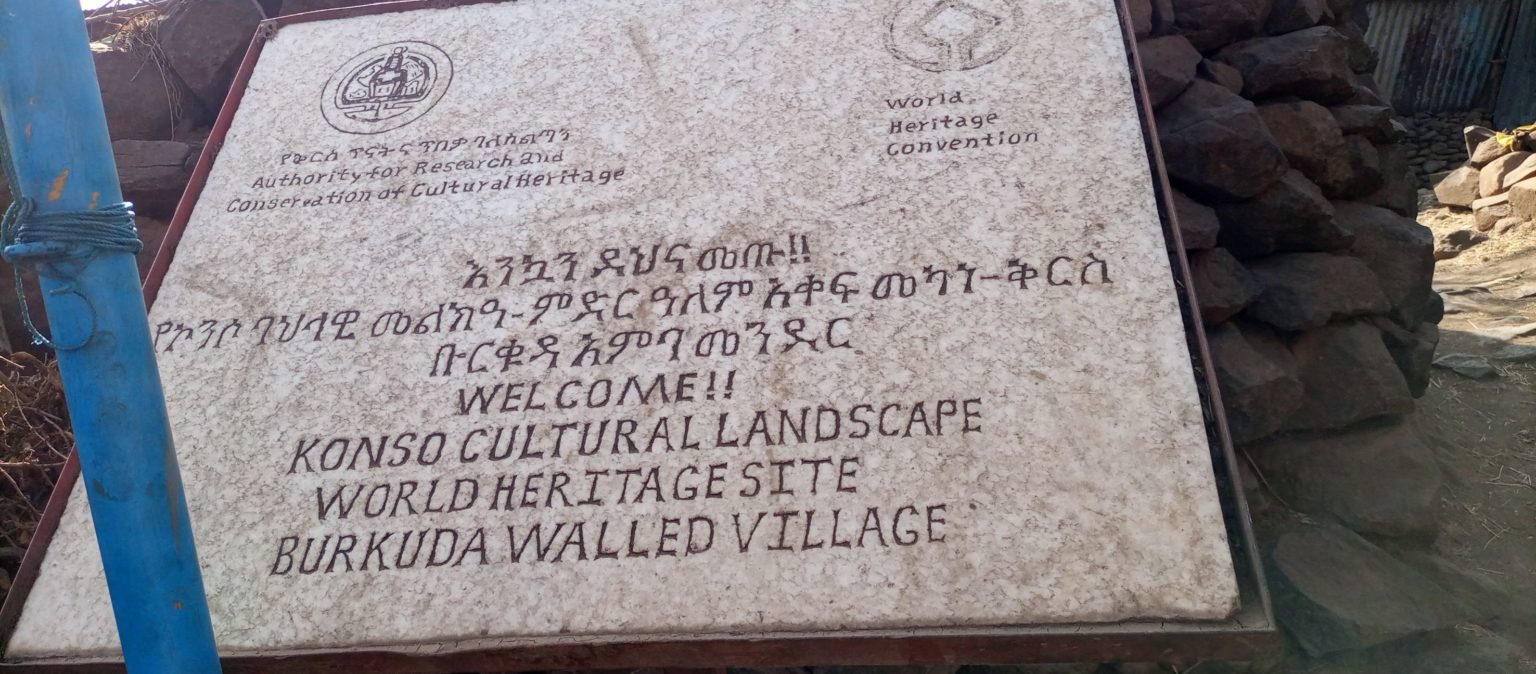Konso

Konso Cultural Landscape represents a traditional way of living known for its construction of dry stone terraces and fortified towns.
The Konso people migrated to these highlands, where they constructed terraces to support agricultural fields. Their cultural tradition has existed for over 400 years in a hostile, dry environment. The area has 12 stone-walled settlements with thatch-roofed public structures and domestic buildings. The Konso are noted for their erection of memorial stelae called waka.
Community Perspective: Solivagant describes the history of its WH inscription and his visit to a village in 2007, while Wojciech visited Gamole village in 2022.
Map of Konso
Load mapCommunity Reviews
Wojciech Fedoruk

Site visited in November 2022. During my trip to Ethiopia, I visited the village of Gamole, which is a living open-air museum and a monument to the culture of the Konso people. Within three lines of stone walls (once protecting against wild animals and invaders, today only of symbolic meaning) people live mainly engaged in farming on the terraces, which are a symbol of the region. Such terraces are commonplace in the Philippines, China or Vietnam, but in Ethiopia they are a real revolution - only the Konso have transformed the landscape in this way, other tribes have treated the mountains as a demarcation line, and only goats graze there from economic activities.
Our fixer arranged a guide with whom we safely explored the village. From the guide we know that the Konso people are divided into 9 clans, and marriage is allowed only with a person from another clan. The people are ruled by a king, and when he dies, everyone pretends to be sick. They embalm the corpse and keep it for 9 years, 9 months and 9 days, and only after this period they stop pretending and celebrate the coronation of the new king, the eldest son of the predecessor. What if there is no son? I don't know, we didn't go into details about Konso's succession rights.
The people are also known for putting so-called waka, wooden monuments in memory of rulers and other distinguished figures. And in the center of the village he puts like masts, tied with a hemp rope every one generation, that is, every 18 years. By counting the bonds, you can check how long a village has existed.
Despite a successful visit, we felt some distaste. Most of the locals posed willingly for photos, but demanded a tip almost immediately. The same with the swarm of children accompanying us everywhere. Konso is quite a well-known place on the tourist map of Ethiopia and, unfortunately, the inhabitants have learned to take advantage of the arriving tourists.
The Konso area is marked in red on the travel warning lists. Indeed, on the way we had a burnt village, located right next to the river separating one tribe from another. The tragic events took place less than two years ago and show that in Ethiopia ethnic tensions are a daily reality not only in Tigray. There were no tensions in Gamole itself, because the village is in the center of a territory inhabited almost exclusively by the Konso people. In 2022 however, as our very sensible driver assured us, this region is perfectly safe.
orkaido kusse
Konso is very special place for me! especially for its settings and natural gifts and talents of the residents. As one one of konso people I feel proud of being from land with such type of natural blessings and from a society with such type of talents. i.e tracing, wood curving(waka), conflict resolution techniques. this is just to say a little of what Konso is endowed with.
Solivagant

As we visited the Konso area of S Ethiopia in Dec 2007 we will be particularly interested to see what actually emerges within the nomination which is currently foreseen for 2010. The description on Ethiopia’s T List entry of 1997 isn’t that exciting – “Konso-Gardula (paleo-anthropological site)….. discovered in 1991. The sites are dated to be between 200.000 and 2000000 years old…. Early and middle pleistocene animals and hominides fossils along with early Acheulian and Oldowan cultural materials ….. Twelve individual hominides identified to be Homo erectus and Australopithicus Boisei…”. Ethiopia already has 2 paleo-anthropological sites inscribed at Lower Awash and Omo and also had another at Melka Kunture deferred in 1980 (which we also saw). Clearly Ethiopia is important for its central role within the East African “Cradle of Mankind” and can be rightly proud of such remains as have been found within its boundaries – but can it be making too much of a “good thing”?
In fact, subsequent documents seem to suggest that the nominated site will cover rather more than these “paleo anthropological remains”. The first is dated 1999 when UNESCO granted $15000 for “Preparatory Assistance - Konso Cultural Landscape”. The documentation states “The Konso region is known for the recent discovery of 17 paleo-anthropological sites dated from the middle and lower Pleistocene age. It is also a remarkable landscape which contains outstanding geo-morphological features, sacred forests and stone terraces”. By 1999 we have a presentation by Yonas Beyune at a “World Heritage Convention and Cultural Landscapes in Africa Expert meeting – Tiwi Kenya”. It concludes “The UNESCO World Heritage preparatory assistance request …… resulted in "Preliminary Report on Konso" outlining the major aspects of the Konso culture. The Konso archaeological sites and cultural landscape meet the criteria for the inclusion of cultural properties in World Heritage List and could be inscribed as a living cultural landscape with associated values.” The site description in PDF pp 99-104 quickly covers the claimed special nature of the paleo anthropological sites and then moves on at far greater length to the “Konso Landscape and Living culture”. The “Cultural Landscape” has become a common approach to inscribing sites of African indigenous culture and this one contains many of the aspects to be found in others – landscapes formed by traditional agricultural techniques, structures and cult objects/locations (in this case terraces, stone walled villages and carved wooden stelae known as “Waga” placed on graves within sacred groves). All “good stuff” – but one is left wondering whether the paleo-anthropological remains really fit in that well with these aspects other than to show that “man” has been in the area a very long time. There is no other “cultural” link between the 2 elements.
So what will you see if you go to Konso? Well of course we don’t yet know exactly which sites within the area will be inscribed and our visit was also hitting an unseen target! If you are travelling from Addis to Omoland you will pass through/eat at or stay in the ugly crossroads town of “Karat” where you are supposed to get permission (and of course pay) to visit the nearby villages- one of which is walkable but most of which really require a vehicle to reach(If you have come from Arba Minch you will also pass through the village of "Gardula" a few miles before you reach Konso-Karat). The Konso are not perhaps as obviously “colourful” in costume and custom as some of the other ethnic groups you will see later on in Omoland such as Hamer, Mursi and Dasenech. Most of the men have moved across to trousers and T shirts – but the women still wear their voluminous and brightly bordered skirts and "woolly hat" hair-dos(photo). We were there on a day when a large group of US missionaries was being “entertained” (If you want to get a feel for how well organized and widespread the US mission agencies are have a look at the Joshua project ! It is also a very useful resource for anyone interested in matters tribal worldwide.) and saw the male costumes as well. We personally found the village visit resulted in too much hassle from the locals for comfort but the other “tourist visit” to see the compound of the Chief was much more rewarding. He is obviously used to “receiving” tourists and, in his excellent English, allowed us an interesting question and answer session in which we gained some feeling for the culture, lives, problems and aspirations of his people. There was no hassle at all from the locals present as we walked around the compound with its various “houses” and to the sacred grove to see the Waga in place (photo). This all provided useful background to more detailed study on our return. The Konso may not be fully “up there” with some other African tribes who have had their homeland UNESCO-inscribed such as the Dogon and Betamaribe but are certainly worth visiting if you are in the area. But just how many such tribes are there across Africa whose “cultural landscapes” could be put forward? Well – possibly at least as many as all the different European ethnic groups who have managed to get some aspect of their culture inscribed!! Oh, and we never made it to whatever remains at the paleo-anthropological sites.
Site Info
- Full Name
- Konso Cultural Landscape
- Unesco ID
- 1333
- Country
- Ethiopia
- Inscribed
- 2011
- Type
- Cultural
- Criteria
-
3 5
- Categories
- Cultural Landscape - Continuing
- Link
- By ID
Site History
2011 Advisory Body overruled
ICOMOS recommended deferral -boundaries, integrity, were "unable" to send a mission. Mal, Nig, Egy, RSA, Jor lead for inscription. Sui, Swe et al against. Secret ballot 14/5 in favour with 1 abst.
2011 Inscribed
2010 Referred
Site Links
Unesco Website
Official Website
Related
Connections
The site has 15 connections
Art and Architecture
Constructions
Ecology
History
Human Activity
Individual People
Religion and Belief
Timeline
Trivia
World Heritage Process
Visitors
46 Community Members have visited.
The Plaque
 (external source)
(external source)